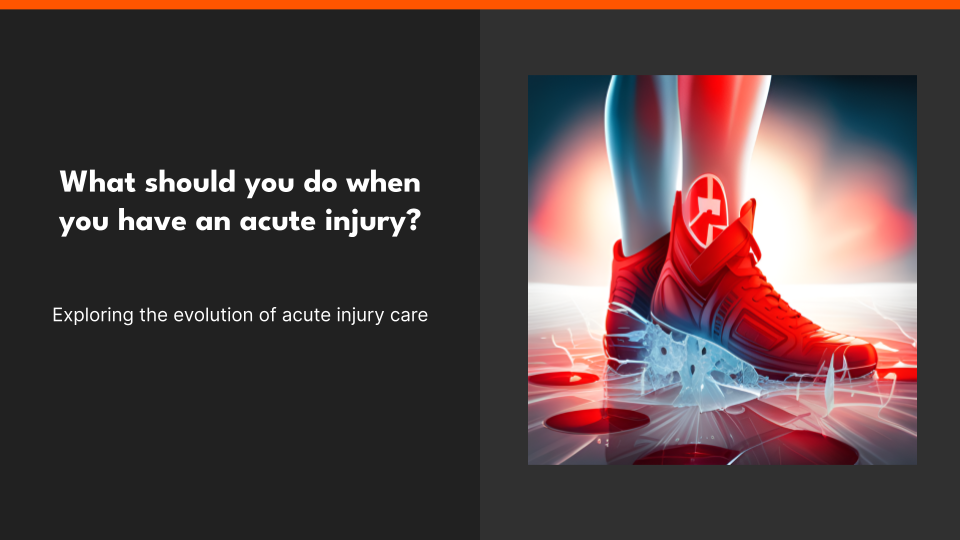Introduction

Experiencing an acute injury sports injury, such as an ankle sprain or muscle strain, can be distressing. It’s natural to feel concerned and unsure about the best course of action for a speedy recovery. In this podcast episode, Dr. Notley, a Winnipeg chiropractor and athletic therapist, explores the evolution of acute injury care over the past 25 years. He discusses how traditional principles have been updated and expanded to provide a more comprehensive approach to healing. This article and podcast delves into the key points discussed in the podcast, highlighting the new principles of injury care.
The Traditional Approach to Acute Sports Injury: The PIER and RICE Principles
In the past, the traditional approach to care revolved around the PIER principle and the RICE principle. These principles focused on pressure, ice, elevation, and rest to reduce pain, inflammation, and swelling. The injured area was protected and given time to heal through limited movement and rest. While these principles had their merits, they neglected other crucial factors in the recovery process.
The Limitations of Traditional Principles
Recent data suggests that the traditional principles may not be the most optimal approach to injury care. They overlook psychological factors that can act as barriers to recovery. Additionally, patients benefit from understanding their injuries and having realistic expectations. Education plays a significant role in improving recovery outcomes. As a result, new principles have emerged to address these limitations.
The PEACE Principle: A Holistic Approach to Acute Injury Care
The PEACE principle introduces a more active and comprehensive approach to rehabilitating acute injuries. It emphasizes protecting the injured area during the first few days, elevating the limb, avoiding anti-inflammatories, applying compression, and educating patients about their injuries. These principles take into account psychological aspects, stress and strain management, tissue remodeling, and functional recovery.
Protect
During the initial one to three days after an injury, it is essential to protect the injured area. Stress should be minimized, and movement should be restricted to reduce the risk of re-aggravation. However, complete immobilization is not necessary, as prolonged rest can compromise tissue strength and quality. Pain serves as a guide for determining the level of protection needed.
Elevate
Elevation, as in the traditional approach, involves raising the injured limb above the heart level. While the evidence supporting its effectiveness is limited, elevation aims to facilitate the removal of swelling from the area by promoting fluid drainage towards the heart.
Avoid Anti-inflammatories
Contrary to common practice, the use of anti-inflammatories and excessive icing may have negative effects on long-term tissue healing. Inflammation plays a crucial role in the healing process, and inhibiting it excessively can hinder collagen synthesis, impair angiogenesis, and delay tendon and bone healing. Controlled inflammation is necessary for optimal recovery.
Compression
Compression, similar to the pressure component in the traditional approach, helps control swelling and bleeding after an injury. It also provides stability while allowing some movement. By reducing swelling, compression minimizes the accumulation of waste products and enhances nutrient and oxygen delivery to the injured area.
Educate
Education is an essential aspect of injury care. Healthcare providers, such as chiropractors and athletic therapists, play a role in educating patients about their injuries, explaining the expected progress, and setting realistic recovery timelines. Patient involvement in the recovery process improves engagement and outcomes. By promoting an active approach to care and managing stress and strain appropriately, patients can optimize their recovery.
The LOVE Principle: Transitioning to Subacute Injury Care
Once the initial days of injury have passed, the focus shifts to the LOVE principle: load, optimism, vascularization, and exercise. This principle aims to promote tissue healing, cardiovascular health, and functional recovery.
Load
Loading the injured tissue through controlled stress and movement is crucial for optimal healing. Stressing the tissue stimulates repair and remodeling processes, leading to increased tissue strength and functional recovery. Pain should be monitored to ensure loading is done within the limits of tolerable pain, avoiding exacerbation.
Optimism
Promoting optimism is vital during the recovery process. Positive thinking and avoiding catastrophic thoughts about the injury contribute to better outcomes. Individuals who are depressed or overly fearful may experience longer recovery times, as their psychological state can hinder progress. Overcoming fear through safe and progressive exposure can help individuals regain confidence in using the injured body part.
Vascularization
Improving cardiovascular health benefits overall physical function and work capacity. Cardiovascular exercise enhances blood flow and oxygen delivery, aiding in tissue healing. Additionally, individuals with improved cardiovascular health often require less pain medication.
Exercise
Exercise plays a pivotal role in the recovery process. Tailored exercises specific to the individual’s sport or activity help restore mobility, strength, and balance. Pain may still be present during exercise, but as long as it does not increase, progress can be made. Continuing to exercise beyond pain relief is crucial for addressing weaknesses and improving muscular endurance, reducing the risk of recurrence.
Conclusion
The evolution of acute injury care has brought about a shift from the traditional principles of pressure, ice, elevation, and rest to the more comprehensive PEACE and LOVE principles. This new approach emphasizes a holistic understanding of injuries, psychological factors, and patient education. By implementing these principles, individuals can actively engage in their recovery, optimize tissue healing, and regain function. The incorporation of load, optimism, cardiovascular health, and exercise allows for a more thorough and effective rehabilitation process. It is essential to work with healthcare providers to tailor injury care to specific activities and goals, ensuring a well-rounded and successful recovery.
Originally posted on June 18, 2024 @ 12:02 pm